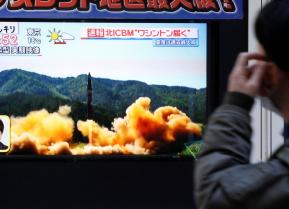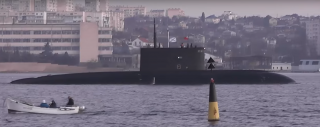Meet the First Russian Submarine To Fire in Anger Since World War II (And Its New Cruise Missiles)
Rostov-on-Don, or B-237, is a modernized Kilo-class attack submarine. The second of eight units commissioned as part of a series called “Project 636.6,” Rostov-on-Don boasts across-the-board iterative improvements over the original Soviet Kilo-class line.
On December 8, 2015, a submerged Russian submarine launched a missile barrage at a Syrian rebel “citadel.” The ensuing press statement from Russia’s Ministry of Defense was nothing short of triumphant: "Several Kalibr submarine-based cruise missiles were launched in salvo by the Rostov-on-Don submarine for the first time. The strike eliminated two command posts of the IS terrorist organization in al-Raqqa province.”
But why would the Russians send a submarine to attack land-based encampments in Syria? There are, after all, any number of more conventional means to target a hostile base in a region where the Russian Army Force has total free reign.
The story of Rostov-on-Don, the first Russian submarine to fire in anger since World War II, shows how the Syrian experience shaped a generation of Russian military personnel while influencing ongoing weapons research and development projects.
Rostov-on-Don, or B-237, is a modernized Kilo-class attack submarine. The second of eight units commissioned as part of a series called “Project 636.6,” Rostov-on-Don boasts across-the-board iterative improvements over the original Soviet Kilo-class line.
These included a slightly more powerful engine and lower noise levels, but the greatest change comes from much more capable armaments. The original Kilo-class Strela-3 missiles were replaced by more versatile 3M-54 and 3M14 Kalibr cruise missiles with a dual anti-ship/land attack function.
Laid down in 2011, Rostov-on-Don was presented to Russia’s Black Sea Fleet in 2014. After completing a series of trials and training exercises in Northwestern Russia, Rostov-on-Don was to make the trek to join with the Fourth Submarine Brigade of the Black Sea Fleet. But while en route, Rostov-on-Don’s crew was notified of a sudden change of plans: they were to take part in a strike against an ISIS stronghold in the Northern Syrian region of Al-Raqqa.
Rostov-on-Don was ordered to fire its Kalibr-PL missiles on several ISIS emplacements. Russian defense minister Sergei Shoigu described the attack in a press conference with Russian President Vladimir Putin: "We used Kalibr cruise missiles from the Rostov-on-Don submarine from the Mediterranean Sea… we can say with complete confidence that fairly serious damage was done to weapons stores and a factory for preparing mines and, naturally, oil infrastructure.”
The same “serious damage” could unquestionably have been inflicted by the many Russian bomber aircraft active in the area, but the use of Rostov-on-Don was far from purposeless. First, it was a live-fire exercise to evaluate Project 636.6 submarines’ combat efficacy against land targets. Second, it was an advertisement for Kalibr’s export variant, the 3M14E “Club-S,” to prospective buyers. Finally, this was one of several displays of Russian sea power to deter Turkish maritime intervention into the Syrian Civil War.
After the success of the Raqqa operation, Rostov-on-Don went on to join up with the Black Sea Fleet as originally planned. However, its Syrian performance did not go unnoticed. In 2017, the Rostov-on-Don became one of two Project 636.6 submarines, along with Novorossiysk, to be awarded Russia’s new honorary military title of “shock” submarine. The Russian Defense Ministry explained that “the right to bear this title goes to submarine crews with a high level of training, demonstrated through the accomplishment of missions with Russian Naval units in the Mediterranean Sea.”
Rostov-on-Don is one of countless Russian weapons to cut its teeth on the Syrian Civil War, providing its crew with live combat experience while furthering Moscow’s export ambitions and geopolitical designs.
Mark Episkopos is a frequent contributor to The National Interest and serves as a research assistant at the Center for the National Interest. Mark is also a Ph.D. student in History at American University.
Image: Youtube screenshot/Russian media.


